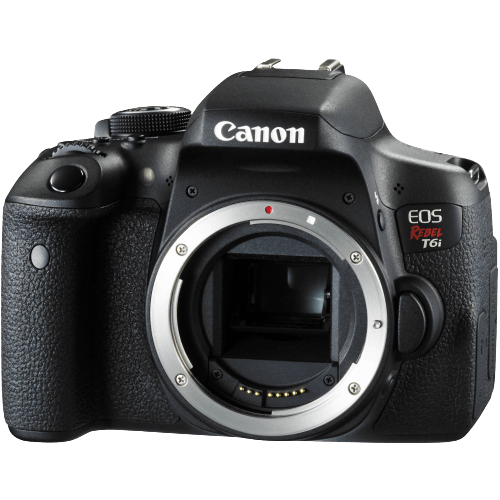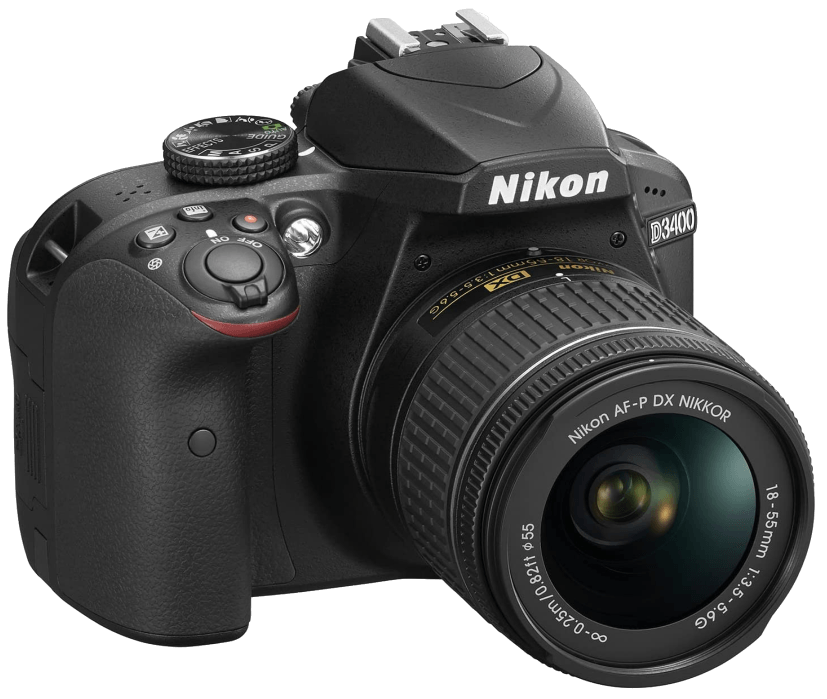Canon EOS Rebel T6i / 750D vs Nikon D3400 Comparison
Canon EOS Rebel T6i / 750D

Nikon D3400

The Nikon D3400 emerges as the winner with a score of 61/100, a 5-point lead over the Canon EOS Rebel T6i / 750D, which scored 56/100. Both cameras are DSLR models released in 2015 and 2016, respectively. They share common specifications, such as launch prices of $750 for the Canon and $650 for the Nikon.
The Canon T6i is larger and heavier, measuring 132 x 101 x 78mm and weighing 1.22lbs, which some may find more comfortable to handle. On the other hand, the Nikon D3400 is more compact and lightweight at 124 x 98 x 76mm and 0.98lbs, making it easier to carry around. The Nikon’s higher score indicates it’s a better camera overall, while the Canon may still appeal to some users due to its size and weight.
Canon EOS Rebel T6i / 750D vs Nikon D3400 Overview and Optics
The Nikon D3400 comes out on top in our optics comparison with a score of 65/100, while the Canon EOS Rebel T6i / 750D trails behind with a score of 59/100. Both cameras share several common specifications, such as 24.2-megapixel resolution, 5 frames per second shooting speed, CMOS sensor type, APS-C sensor size, and the lack of image stabilization. They also have their respective lens mounts: Canon EF-S for the T6i and Nikon F DX for the D3400.
The Nikon D3400 outperforms the Canon T6i in terms of sensor performance, as evidenced by its higher DXOMARK score of 86, compared to the T6i’s score of 71. This difference indicates that the D3400’s sensor captures more accurate colors, has better low-light performance, and delivers a higher dynamic range than the T6i. Additionally, the D3400 uses the Expeed 4 processor, while the T6i uses the Digic 6 processor. Although both processors are efficient, the Expeed 4 provides the D3400 with a slight edge in terms of image quality and performance.
On the other hand, the Canon T6i does not have any significant advantages over the Nikon D3400 in the optics department. However, it is essential to consider other factors such as ergonomics, build quality, and the availability of compatible lenses when choosing a camera.
Taking all these factors into account, the Nikon D3400 emerges as the superior choice in terms of optics. Its higher DXOMARK score and Expeed 4 processor contribute to better image quality, making it the better option for photographers looking to capture sharp, vibrant images. However, potential buyers should also consider other factors beyond optics to make the best decision for their needs.
Canon EOS Rebel T6i / 750D vs Nikon D3400 Video Performance
The Nikon D3400 emerges as the winner in the video capabilities comparison against the Canon EOS Rebel T6i / 750D, with a score of 56 out of 100, a 13-point lead over the Canon’s 43 points. Both cameras share some common specifications, including Full HD maximum video resolution and video dimensions of 1920 x 1080. Neither camera has built-in time-lapse functionality.
The Nikon D3400 outperforms the Canon T6i / 750D in terms of maximum video frame rate, offering 60fps compared to the Canon’s 30fps. This higher frame rate allows the Nikon D3400 to capture smoother and more detailed footage, particularly in fast-paced or action-packed scenes.
While the Canon T6i / 750D trails in terms of video frame rate, it still delivers decent video quality with its Full HD resolution and 1920 x 1080 video dimensions. However, these similarities in video resolution and dimensions do not make up for the significant difference in frame rate between the two cameras.
Considering the video capabilities of both cameras, the Nikon D3400 proves to be the superior choice due to its higher frame rate, which results in smoother and more detailed video footage. On the other hand, the Canon EOS Rebel T6i / 750D offers acceptable video quality but falls short when compared to the Nikon D3400’s performance.
Canon EOS Rebel T6i / 750D vs Nikon D3400 Features and Benefits
The Canon EOS Rebel T6i / 750D emerges as the winner with a feature score of 57/100, while the Nikon D3400 scores slightly lower at 54/100. Both cameras share some common specifications, such as a 3-inch screen size and the absence of GPS functionality.
The Canon T6i has a higher screen resolution of 1,040,000 dots compared to the Nikon D3400’s 921,000 dots. This difference gives the Canon T6i a clearer and sharper display. The Canon T6i also has a touchscreen, making it more user-friendly and easier to navigate. Additionally, the Canon T6i features a flip screen, which is beneficial for capturing photos and videos from different angles. The presence of Wi-Fi in the Canon T6i allows for easy sharing and transferring of files.
On the other hand, the Nikon D3400 has Bluetooth connectivity, unlike the Canon T6i. This feature enables seamless connection with compatible devices for remote control and file sharing.
To sum up, the Canon EOS Rebel T6i / 750D has better features, such as a higher screen resolution, a touchscreen, a flip screen, and Wi-Fi connectivity, which contribute to its higher score. The Nikon D3400, while having a slightly lower score, still offers Bluetooth connectivity as an advantage over the Canon T6i. Ultimately, the choice between these two cameras depends on the specific needs and preferences of the user.
Canon EOS Rebel T6i / 750D vs Nikon D3400 Storage and Battery
The Nikon D3400 outperforms the Canon EOS Rebel T6i / 750D in storage and battery, scoring 45/100 compared to the Canon’s 24/100. Both cameras have one memory card slot and accept SD, SDHC, and SDXC memory cards. However, the Canon T6i / 750D is compatible with UHS-I cards, providing faster transfer speeds.
The Nikon D3400 excels in battery life, offering 1200 shots per charge compared to the Canon T6i / 750D’s 440 shots. This significant difference makes the Nikon D3400 a better choice for extended shooting sessions. Both cameras use different battery types: the Canon T6i / 750D uses an LP-E17 battery, while the Nikon D3400 uses an EN-EL14a battery. Neither camera supports USB charging.
In terms of storage and battery, the Nikon D3400 is the clear winner due to its superior battery life. Although the Canon T6i / 750D offers compatibility with faster memory cards, this advantage is not enough to outweigh the significant difference in battery performance.
Canon EOS Rebel T6i / 750D vs Nikon D3400 Alternatives
Are you still looking for the perfect camera to buy? Have a look at the following camera comparisons for more inspiration:
